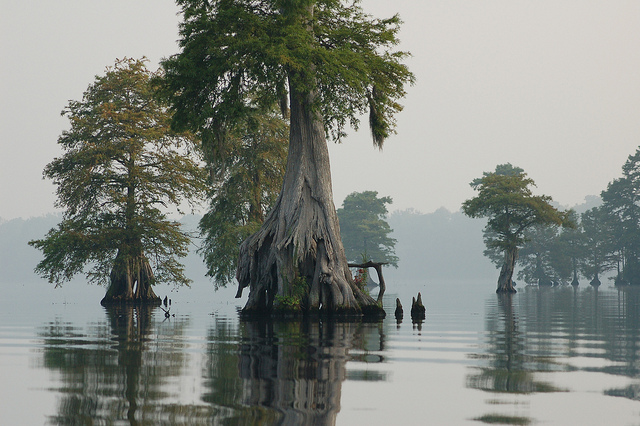
“The Great Dismal Swamp National Wildlife Refuge,” U.S. Fish and Wildlife Service, 2011. (USFWS via Flickr)
When we try to make sense of the past, we turn to records, and yet records are not neutral. In a previous piece on historiographies of Haiti, Canada, and the U.S., I discussed how the histories that are documented in our archives and on our monuments reflect the politics of their creation; the fragments outside the narrative are actively absented. As late Martinican writer Aimé Césaire reminds us, absence itself is a revelation. In his epic poem, Cahier d'un retour au pays natal (Notebook of a Return to the Native Land), he observes that documentation is a value-laden process. He writes that, for colonized people, narratives of place and ways of knowing are not fully captured within colonial records:
“At the end of the small hours these countries whose past is uninscribed on any stone, these roads without memory, these winds without a log.
Does that matter?
We shall speak. We shall sing. We shall shout.”1
Colonization hinges on dispossession, and although the possessed aspects of black life regularly seeped into colonial records — what skills does this man hold? what is the price of that woman? — the souls of black folk were largely silenced. Yet Césaire was writing at the dawn of Martinique’s decolonization, when subjects became citizens, so his observations did not stop with the absenting of blackness from historical narratives. We shall speak, we shall sing, we shall shout. His is a revisionist call, to reclaim that which was obscured in the past; and yet, perhaps more importantly, he is signifying that the collective voices of emergent decolonized nations in fact join a chorus that was already present. We were always speaking, singing, shouting, regardless of whether there is any evidence of it at all.
Similarly, territories of black life are not readily reflected on the maps of states developed through black dispossession. Knowing this, scholars thinking through the framework of black geographies are advancing alternative ways of imagining space, rooted in the promise and project of collective liberation. As key black geographies theorist Katherine McKittrick notes, “the profoundly disturbing nowhere of black life, in fact, provides a template to imagine the production of space not through patriarchal and colonial project trappings… [but as] an outlook that is structured by, but not beholden to, crass positivist geographies.”2
Many have probed at the unknowable spatial histories of people stripped of their humanity, and some have started these inquiries at the site of diasporic rupture. In Lose Your Mother, writer Saidiya Hartman traces her own journey back across the Atlantic in search of the unrecoverable.3 She charts the disruptions of collective black life in the wake of the Atlantic slave trade, capturing with painful precision her encounters with the mutual ambivalences between continental and diasporic Africans towards the others’ wounds. Her work offers no easy answers, but she closes with a discussion of Gwolu, a town in northwestern Ghana founded by people who came together in search of refuge. Like the maroon communities of the Great Dismal Swamp and the highlands of Veracruz, it was in Gwolu that the dream of autonomy was built by freedom seekers. For Hartman, Gwolu is not a recovery of lost roots; rather, it is the site where she recognizes shared legacies of fugitivity.
Late historian Stephanie Camp mined fragments in the archives to construct a spatial history of black freedom practices that were developed within the confines of antebellum plantation life.4 Drawing from postcolonial theorist Edward Said’s concept of rival geographies, Camp demonstrated how enslaved people manipulated their knowledges of plantation landscapes, cultivated through a lifetime of place-based bondage, toward the cause of freedom. Whether assisting freedom seekers by providing shelter or resources, coming together at the plantation’s edges for nighttime gatherings, or even temporarily fleeing, enslaved people utilized their spatial knowledge to disrupt and destabilize the efficacy of plantation order. This rival geography offered enslaved people “alternative ways of knowing and using plantation and southern space that conflicted with planters’ ideals and demands.”5
![A+negro+funeral+[graphic].](https://data.monumentlab.com/uploads/monument-lab/originals/beebd3f5-3c79-4c8b-a270-8140f7bd193f.jpg)
“A Negro Funeral.” Harper’s New Monthly Magazine 1859. Published in Camp 2004. Original caption: “It was in the remote spaces in the woods bordering plantations that enslaved people gathered for funerals, religious services, and secret, secular parties.” (Library Company of Philadelphia)
The rival geographies of plantation life are vividly imagined in The Known World, a novel by Edward P. Jones.6 In this work, the contested territories of the fictional Manchester County, Virginia, are richly depicted through the nighttime wanderings of Alice, an enslaved woman who is presumed by all to have lost her mind. Regularly leaving her cabin in the darkness of night, she crosses the threshold of the Townsend Plantation and sets out along the roads that lay beyond. These spatial transgressions lead to her liberation. Though her walks are chalked up to the harmless acts of a senseless woman, they enable her to survive encounters with patrollers that leave others assaulted or worse, and the ultimate goal of her strategic meanderings is to chart a path to freedom. The novel concludes some years after her successful escape at an exhibition of her tapestries: two maps, one of the Townsend Plantation, the other of Manchester County, in which every road and cemetery, cabin and person (living and dead), is depicted. “A ‘map’ is such a poor word for such a wondrous thing,” observed one on-looker. “It is what God sees when He looks down on Manchester.”7 Even as structures of power limit recognition of territorial claims to propertied classes, understanding rival geographies reveals that different ways of knowing space are always already underway.
Hartman’s expansive search for the past, Camp’s close reading of archival fragments, and Jones’ historical fiction all create ways of imagining and mapping the unrecoverable. Where the records stop — where the stories are silenced — the work begins.
